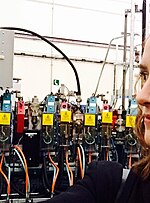Sci-Tech Daresbury
Science and Technology Facilities CouncilScience and technology in CheshireScience parks in the United KingdomUse British English from May 2020

Sci-Tech Daresbury, also known as Sci-Tech Daresbury Enterprise Zone, is a science and innovation campus near the village of Daresbury in Halton, Cheshire, England. The site began life as the Daresbury Laboratory later adding the Cockcroft Institute, Innovation Centre, Vanguard House and ITAC. Over 1,300 people work on the campus for nearly 150 high tech companies. The science park was formerly known as Daresbury Science and Innovation Campus. In 2012 it was given enterprise zone status and renamed Sci-Tech Daresbury.
Excerpt from the Wikipedia article Sci-Tech Daresbury (License: CC BY-SA 3.0, Authors, Images).Sci-Tech Daresbury
Keckwick Lane,
Geographical coordinates (GPS) Address Website External links Nearby Places Show on map
Geographical coordinates (GPS)
| Latitude | Longitude |
|---|---|
| N 53.343 ° | E -2.6405 ° |
Address
Sci-Tech Daresbury
Keckwick Lane
WA4 4AD
England, United Kingdom
Open on Google Maps








